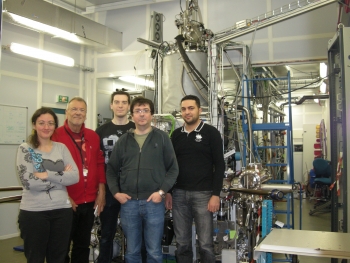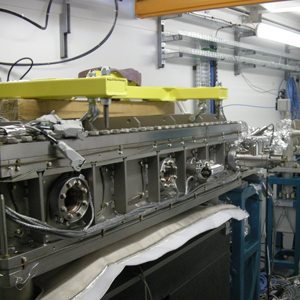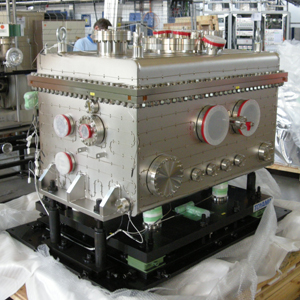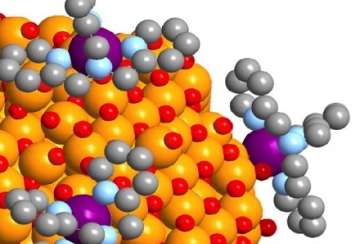
DEIMOS, Dichroism Experimental Installation for Magneto-Optical Spectroscopy, is a beam-line dedicated to the study of the magnetic and electronic properties using polarized light.
 The application of synchrotron radiation to magnetism is related to the development of circularly polarized sources. The main advantage of X-ray Magnetic Circular Dichroism (XMCD) over other techniques addressing magnetic behavior lies in its chemical and orbital selectivity. One can probe the magnetic moment of one specific atom in a compound in which the absorbing atom is not a major component. Due to the electric dipole nature of the Hamiltonian interaction, one can also probe specific shells for which the magnetic orbital and magnetic spin moments can be “independently” measured. New physical and chemical properties shown by different classes of materials provide the basis for promising applications and challenging scientific investigations. The knowledge of the electronic structure of these materials is of crucial importance for the understanding and tailoring of well defined properties, like transport, magnetism and others.
The application of synchrotron radiation to magnetism is related to the development of circularly polarized sources. The main advantage of X-ray Magnetic Circular Dichroism (XMCD) over other techniques addressing magnetic behavior lies in its chemical and orbital selectivity. One can probe the magnetic moment of one specific atom in a compound in which the absorbing atom is not a major component. Due to the electric dipole nature of the Hamiltonian interaction, one can also probe specific shells for which the magnetic orbital and magnetic spin moments can be “independently” measured. New physical and chemical properties shown by different classes of materials provide the basis for promising applications and challenging scientific investigations. The knowledge of the electronic structure of these materials is of crucial importance for the understanding and tailoring of well defined properties, like transport, magnetism and others.
Team
Job opportunities
Contact job offers
Technical data
350 – 2500 eV
E/ΔE between 6000 and 10000 over the whole energy range
1st - APPLE II HU52
2nd - EMPHU65 with a polarization switching rate of 10Hz
~ 2x1015 phot/s/0.1%bw @ 750eV
Double mirror (2 mirrors with 2 incidence angles, insuring a good harmonic rejection over the entire energy range);
PGM with VGD gratings (1200 and 1600 lines) working in the Petersen mode + multilayer gratings for the “high” energy range (>1500eV);
Post-focusing Wolter system.
The optics design is intended to give high stability and high spectral purity.
80x80µm2 and 800x800µm2 (using 2 mirrors stages in the Wolter system).
~ 6x1012 phot/s/0.1%bw @ 750eV
Absorption in TEY (Total Electron Yield) and FY (Fluorescence Yield) modes and transmission.
Variable polarization (circular, continuous linear). EMPHU65 will give 10Hz switching rate between circular left and right polarizations.
Scientific opportunities
| Surface and interface magnetism, Materials for spin electronics |
Magnetic properties of low dimensional structures – size effects; correlation between magnetic properties, morphology and structure - magnetoelastic effects, contributions in the magnetic anisotropy; magnetic moments and anisotropy of isolated atoms - tunneling surface diffusion at very low temperatures; ferromagnetic-antiferromagnetic interfaces – origin of the exchange coupling; magnetic tunnel junctions; etc. |
|---|---|
| Molecular magnets, Langmuir-Blodgett films, Hybrid magnetic materials, High spin molecules |
Magnetic and electronic properties of pure molecular magnets (dichroism of small magnetic polarization of the NO groups, with site selectivity); organo-metallic compounds and supramolecular assemblies – large variety of magnetic structures tuning chemical properties, “exotic” magnetic structures and mechanisms; lamellar compounds – ferrimagnetism, magnetic frustration; polynuclear molecules with monodisperse magnetic properties (moments and anisotropy) – molecular electronics, q-bits. |
| Superparamagnetic nanoparticles, Earth Science, Paleomagnetism |
Magnetic properties of variously synthesized particles of magnetite (Fe3O4), maghemite ((γ-Fe2O3), hematite (α-Fe2O3), pyrrhotite (Fe1-xS) or greigite (Fe3S4) - magnetic surface canting, chemical and magnetic disorder, vacancies ordering. |
Sample environnement
End Station Cryo-magnet: +/-7T (along the beam direction) and +/- 2T (perpendicular to the beam); from 1.5K up to 350K on the sample.
There are ![]() (1.11 MB) (
(1.11 MB) ( ![]() MBE (1016.06 KB) and
MBE (1016.06 KB) and ![]() (887.88 KB) connected to the beamline which are dedicated to sample preparation and treatment (Ar+ etching gun, annealing up to 1500K, evaporation – EFM3, EFM3T) and analysis under UHV conditions (LEED, AES, variable temperature STM).
(887.88 KB) connected to the beamline which are dedicated to sample preparation and treatment (Ar+ etching gun, annealing up to 1500K, evaporation – EFM3, EFM3T) and analysis under UHV conditions (LEED, AES, variable temperature STM).
A![]() (528.33 KB) is also available for air sensitive sample preparation and/or insertion into the beamline.
(528.33 KB) is also available for air sensitive sample preparation and/or insertion into the beamline.
Finally a “suitcase” may be borrowed to transport your sample from your laboratory to SOLEIL.
![]() (557.12 KB) and transfer system compatible with Omicron standards.
(557.12 KB) and transfer system compatible with Omicron standards.

The buffer chamber and DiagOn
 The buffer chamber and the DiagOn are located in the radiation-protection hutch.
The buffer chamber and the DiagOn are located in the radiation-protection hutch.
Since February 2009 we have been using successfully the DiagOn for the commissioning for our Apple-II undulator.
The first optics chamber
 The first optics chamber(a.k.a. M1) is optimised for harmonic rejection over the full energy range. It contains 3 mirrors: frist a plane mirror (SiC) that dissipates 160W of the in-coming power followed by two toroidal mirrors (Pt coated Si and Rh coated Si), which orient the beam onto the entrance slits of the monochromator.
The first optics chamber(a.k.a. M1) is optimised for harmonic rejection over the full energy range. It contains 3 mirrors: frist a plane mirror (SiC) that dissipates 160W of the in-coming power followed by two toroidal mirrors (Pt coated Si and Rh coated Si), which orient the beam onto the entrance slits of the monochromator.
Monochromator
 Based on dispersing Petersen principle the monochromator consists of 2 interchangeable gratings; a Variable Groove Depth (350eV-1500eV) and a Multilayer grating (100eV-2500eV).
Based on dispersing Petersen principle the monochromator consists of 2 interchangeable gratings; a Variable Groove Depth (350eV-1500eV) and a Multilayer grating (100eV-2500eV).
(installed February 2010)
Exit slits
 Intended to provide an energy resolution up to 20 000 (5000 nominal).
Intended to provide an energy resolution up to 20 000 (5000 nominal).
Refocussing (Wolter) chamber
 Will allow two beam-spot sizes of 50μmx50μm and 500μmx500μm on the sample.
Will allow two beam-spot sizes of 50μmx50μm and 500μmx500μm on the sample.
End-stations
 1) Cryo-magnet: Superconducting coils providing a filed of +/-7 Tesla along the beam direction and +/-2 Tesla normal to the beam, at a temperature of 1.5K-370K. (installed May 2010)
1) Cryo-magnet: Superconducting coils providing a filed of +/-7 Tesla along the beam direction and +/-2 Tesla normal to the beam, at a temperature of 1.5K-370K. (installed May 2010)
2) Electromagnetic coils providing a flied of +/-1 Tesla at a switching rate of 10Hz and at a temperature of 20K-1000K.

Sample preparation chambers (installed)

Conferences:

6th European Conference on Molecular Magnetism
August 27th - 31st 2017
Bucharest, Romania
Organized by the European Institute of Molecular Magnetism and COST action MOLSpin, the event will bring together academics, researchers and scientists from around the world interested in molecular magnetism. Through out the four days the conference will host keynote speakers with plenary and invited lectures, oral presentations and poster sessions and will be the stage for interactions and discussions related to the most recent topics on molecular magnetism.
Following the ECMM conferences in Tomar (2006), Wroclaw (2009), Paris (2011), Karlsruhe (2013) and Zaragoza (2015), ECMM2017 in Bucharest will keep the bar high with a rich scientific program.
School:

October 9th - 21st 2017
Cargèse, Corsica, France.
Like previous editions of ESM, the 2017 School aims at providing a thorough understanding of magnetism based on a broad series of fundamental lectures, while offering the latest insights into up-to-date aspects of magnetism with lectures focusing on a special topic. The topic covered in 2017 will be modern aspects overlapping condensed matter in bulk materials on one side, and nanomagnetism/spintronics on the other side. The detailed topics to covered are: basic concepts, magnetism in matter, tools, magnetization textures and dynamics, materials and effects, industry perspectives.
The School is addressed at young scientists, mainly PhD students and post-docs, both experimentalists and theoreticians. It will consist of a ten-day training of lectures and practicals provided by prominent scientists active in today's research, interactive question sessions, access to a library of magnetism-related books, and industrial contributions. The program is available here.
Links:
Groupe de contact Rayonnement Synchrotron


